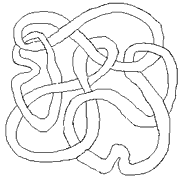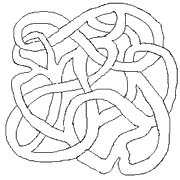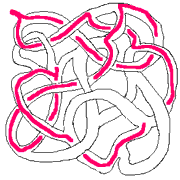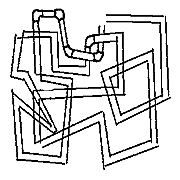Over and Under Mazes | |
|
Step One: Construct the Foundation For this version (and you are still playing, remember), start with a looping line and make it double. Add several more sets of wandering double lines.
|
 |
 |
Step Two: Make the Over and Under Start with any one of the loops. Where this intersects with another loop, erase the secon loop's set of double lines where it crossed the first loop. This will make the first one appear to go over the intersecting loop. At the next intersection, erase the other set of lines which will make the first one seem to go under. On the next loop, start with an intersection that has already been modified and move around the loop, alternating the overs and unders. If you goof, just redraw in the line portions. If you end up with two overs or unders side by side, check to see why and then modify if needed, add a new section of loop to make an intersection betwen them, or just leave it that way.
|
| Step Three: Complicate the Foundation Now comes the real fun. Add connectors. They can join two paths, go over or under, or lead to a dead end. Notice what a 3-D look you are getting. By changing the thickness of the paths you can create the illusion of real depth.
|
 |
 |
Step Four: Check the Solution Path For this kind of maze you can set your own solution rules. For this one I traced a path that came out where it started.
Tip: If you decide to make this style of maze as a quilt and want to use solid fabric paths, indicate crossovers by interrupting the lower strip of fabric.
|
|
Other Design Possibilities The image at right is the start of a "pipe" maze, using straight lines as the starting paths and adding curved connectors at the corners. I doubt if any self-respecting plumber would tackle this project, but you can design it to be as perspectively correct as you wish. Start with graph paper or an isometric grid. (For a free program that prints a useful variety of graph papers, click here.) |
 |
|
Celtic designs are "over and under " patterns and can be adapted for this purpose.Check this site or create Celtic mazes on line with a Java applet. And just for the fun of it, Steve Abbot has a small program you can download to draw "hose mazes" Celtic style. Chinese lattice designs are another possibility. The definitive book on this is Chinese Lattice Designs by Daniel Sheets Dye, Dover Press, available from amazon.com |
|
|
Back: "HauntedHouse' Mazes Back: "Labyrinth Mazes" | |
